Change Management
VerifiedAdded on 2022/12/26
|11
|2306
|1
AI Summary
This report discusses the impact and success of change management at Starbucks, including barriers faced, leadership approaches, and implementation strategies.
Contribute Materials
Your contribution can guide someone’s learning journey. Share your
documents today.
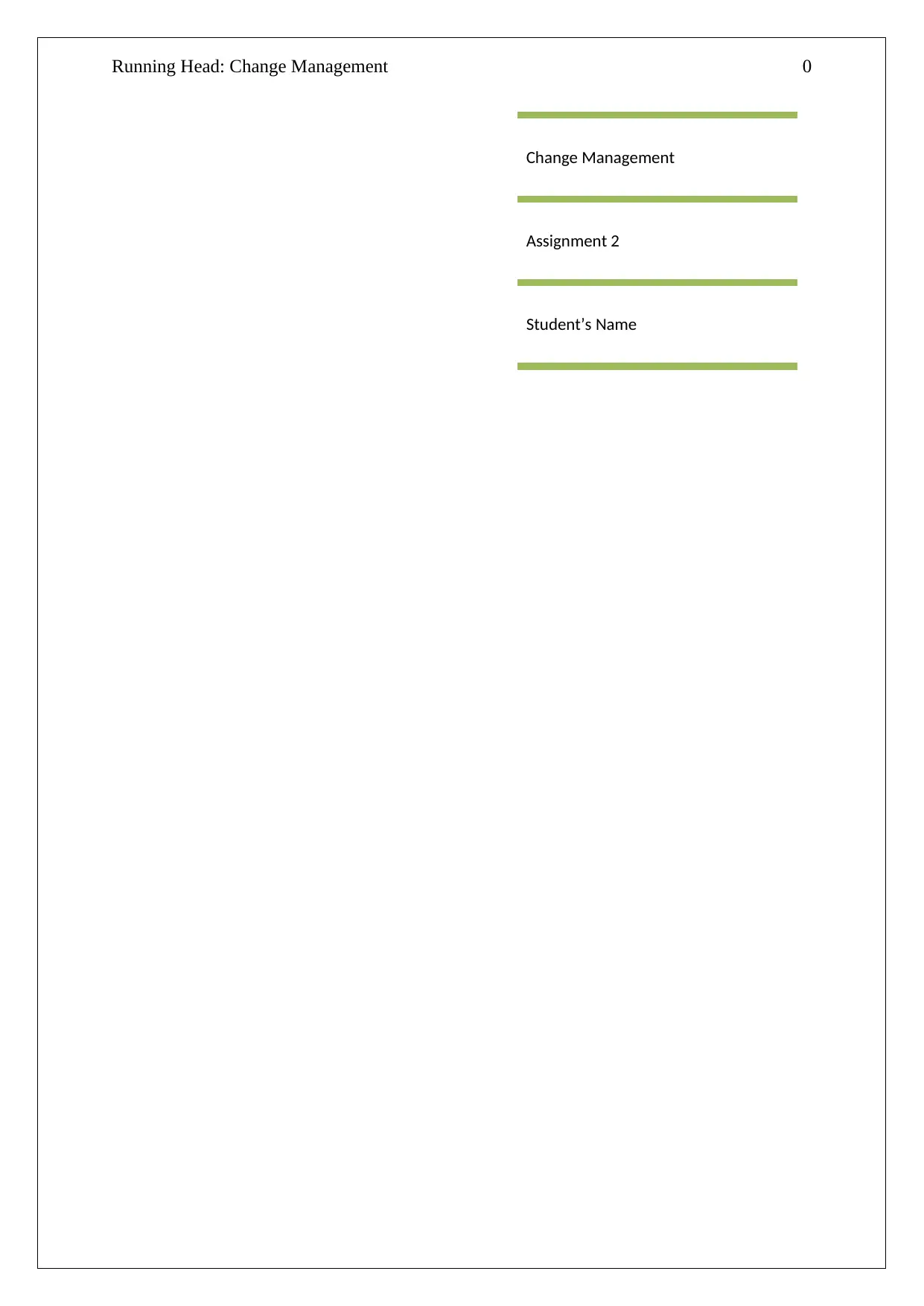
Running Head: Change Management 0
Change Management
Assignment 2
Student’s Name
Change Management
Assignment 2
Student’s Name
Secure Best Marks with AI Grader
Need help grading? Try our AI Grader for instant feedback on your assignments.
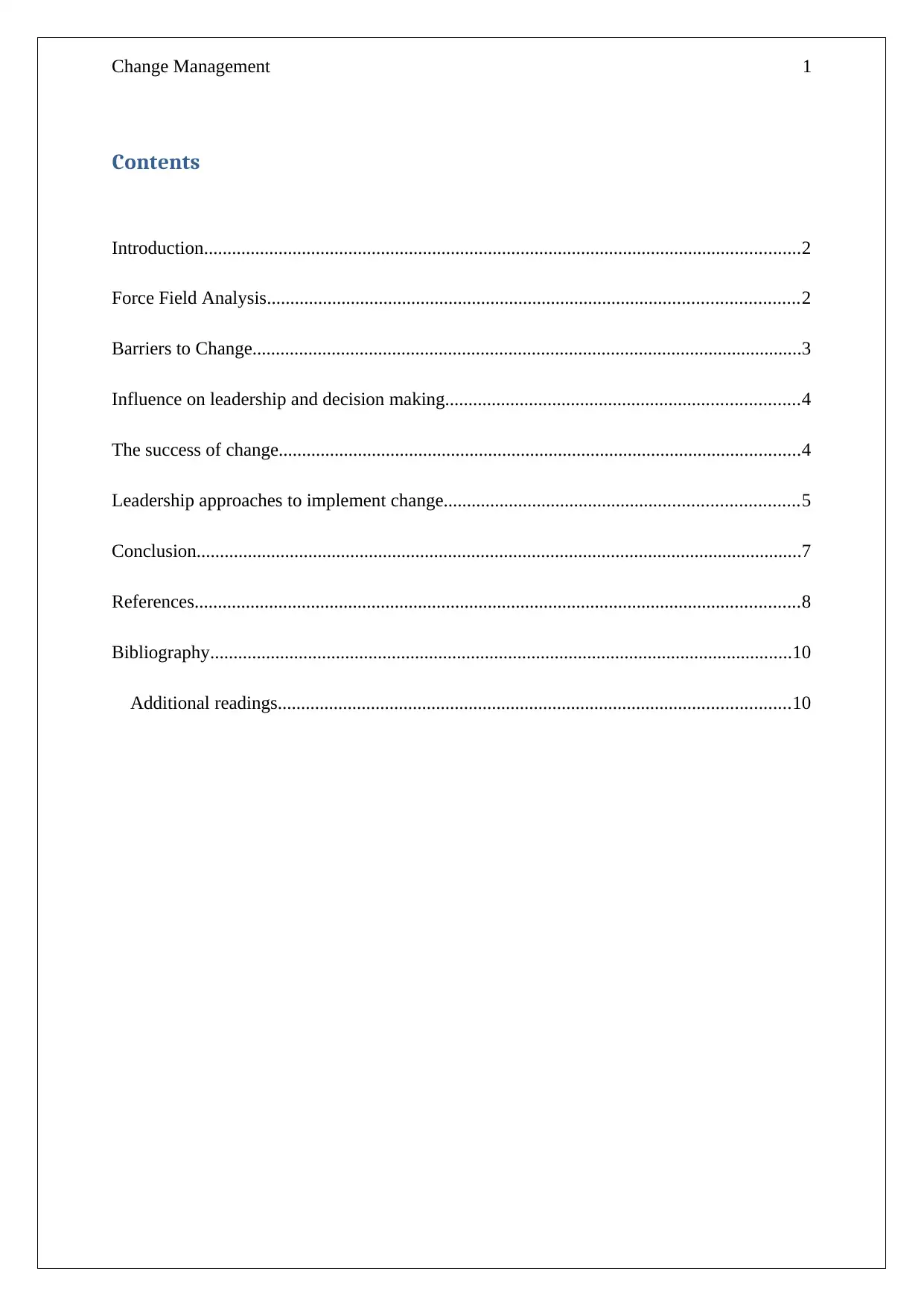
Change Management 1
Contents
Introduction................................................................................................................................2
Force Field Analysis..................................................................................................................2
Barriers to Change......................................................................................................................3
Influence on leadership and decision making............................................................................4
The success of change................................................................................................................4
Leadership approaches to implement change............................................................................5
Conclusion..................................................................................................................................7
References..................................................................................................................................8
Bibliography.............................................................................................................................10
Additional readings..............................................................................................................10
Contents
Introduction................................................................................................................................2
Force Field Analysis..................................................................................................................2
Barriers to Change......................................................................................................................3
Influence on leadership and decision making............................................................................4
The success of change................................................................................................................4
Leadership approaches to implement change............................................................................5
Conclusion..................................................................................................................................7
References..................................................................................................................................8
Bibliography.............................................................................................................................10
Additional readings..............................................................................................................10
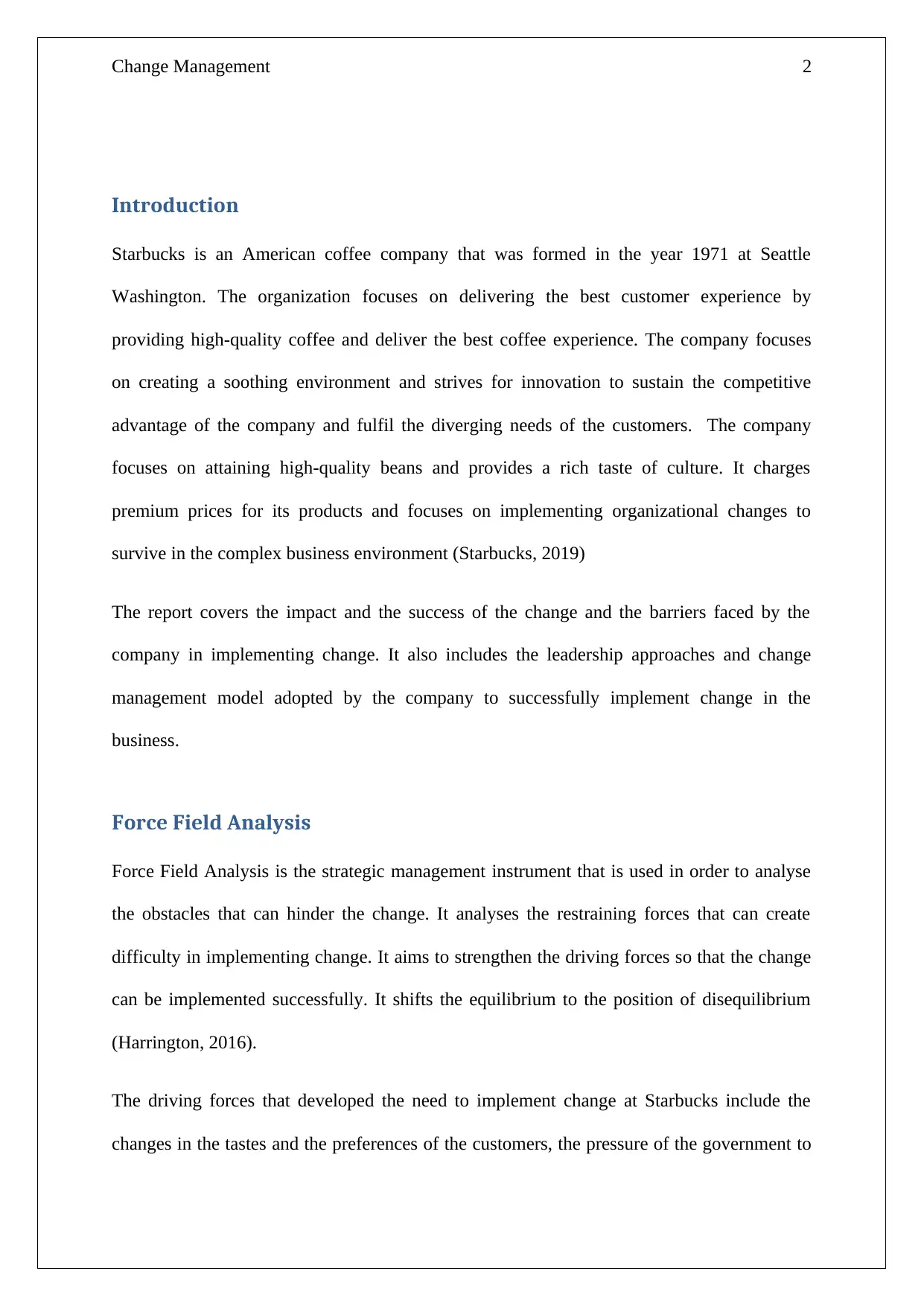
Change Management 2
Introduction
Starbucks is an American coffee company that was formed in the year 1971 at Seattle
Washington. The organization focuses on delivering the best customer experience by
providing high-quality coffee and deliver the best coffee experience. The company focuses
on creating a soothing environment and strives for innovation to sustain the competitive
advantage of the company and fulfil the diverging needs of the customers. The company
focuses on attaining high-quality beans and provides a rich taste of culture. It charges
premium prices for its products and focuses on implementing organizational changes to
survive in the complex business environment (Starbucks, 2019)
The report covers the impact and the success of the change and the barriers faced by the
company in implementing change. It also includes the leadership approaches and change
management model adopted by the company to successfully implement change in the
business.
Force Field Analysis
Force Field Analysis is the strategic management instrument that is used in order to analyse
the obstacles that can hinder the change. It analyses the restraining forces that can create
difficulty in implementing change. It aims to strengthen the driving forces so that the change
can be implemented successfully. It shifts the equilibrium to the position of disequilibrium
(Harrington, 2016).
The driving forces that developed the need to implement change at Starbucks include the
changes in the tastes and the preferences of the customers, the pressure of the government to
Introduction
Starbucks is an American coffee company that was formed in the year 1971 at Seattle
Washington. The organization focuses on delivering the best customer experience by
providing high-quality coffee and deliver the best coffee experience. The company focuses
on creating a soothing environment and strives for innovation to sustain the competitive
advantage of the company and fulfil the diverging needs of the customers. The company
focuses on attaining high-quality beans and provides a rich taste of culture. It charges
premium prices for its products and focuses on implementing organizational changes to
survive in the complex business environment (Starbucks, 2019)
The report covers the impact and the success of the change and the barriers faced by the
company in implementing change. It also includes the leadership approaches and change
management model adopted by the company to successfully implement change in the
business.
Force Field Analysis
Force Field Analysis is the strategic management instrument that is used in order to analyse
the obstacles that can hinder the change. It analyses the restraining forces that can create
difficulty in implementing change. It aims to strengthen the driving forces so that the change
can be implemented successfully. It shifts the equilibrium to the position of disequilibrium
(Harrington, 2016).
The driving forces that developed the need to implement change at Starbucks include the
changes in the tastes and the preferences of the customers, the pressure of the government to
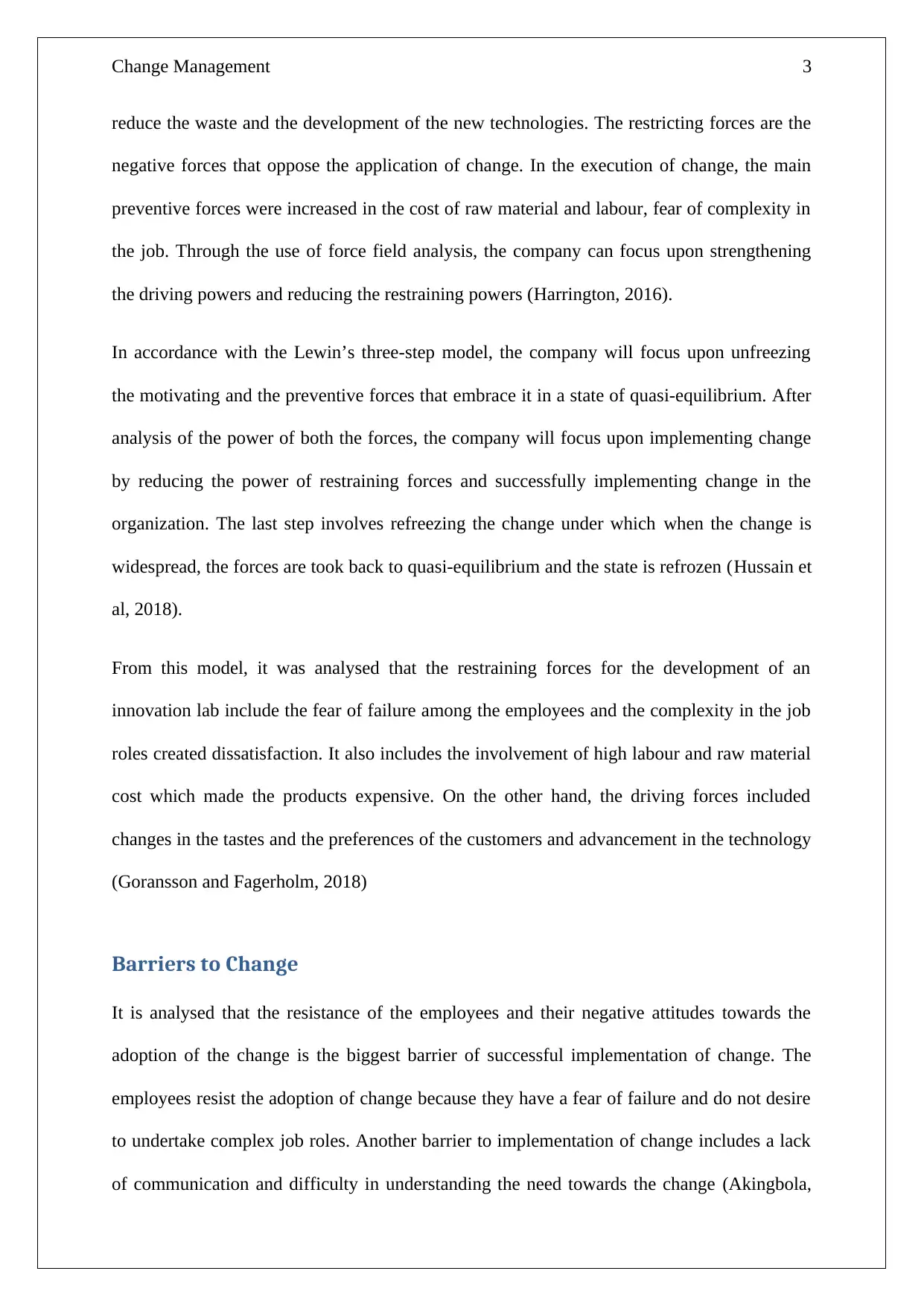
Change Management 3
reduce the waste and the development of the new technologies. The restricting forces are the
negative forces that oppose the application of change. In the execution of change, the main
preventive forces were increased in the cost of raw material and labour, fear of complexity in
the job. Through the use of force field analysis, the company can focus upon strengthening
the driving powers and reducing the restraining powers (Harrington, 2016).
In accordance with the Lewin’s three-step model, the company will focus upon unfreezing
the motivating and the preventive forces that embrace it in a state of quasi-equilibrium. After
analysis of the power of both the forces, the company will focus upon implementing change
by reducing the power of restraining forces and successfully implementing change in the
organization. The last step involves refreezing the change under which when the change is
widespread, the forces are took back to quasi-equilibrium and the state is refrozen (Hussain et
al, 2018).
From this model, it was analysed that the restraining forces for the development of an
innovation lab include the fear of failure among the employees and the complexity in the job
roles created dissatisfaction. It also includes the involvement of high labour and raw material
cost which made the products expensive. On the other hand, the driving forces included
changes in the tastes and the preferences of the customers and advancement in the technology
(Goransson and Fagerholm, 2018)
Barriers to Change
It is analysed that the resistance of the employees and their negative attitudes towards the
adoption of the change is the biggest barrier of successful implementation of change. The
employees resist the adoption of change because they have a fear of failure and do not desire
to undertake complex job roles. Another barrier to implementation of change includes a lack
of communication and difficulty in understanding the need towards the change (Akingbola,
reduce the waste and the development of the new technologies. The restricting forces are the
negative forces that oppose the application of change. In the execution of change, the main
preventive forces were increased in the cost of raw material and labour, fear of complexity in
the job. Through the use of force field analysis, the company can focus upon strengthening
the driving powers and reducing the restraining powers (Harrington, 2016).
In accordance with the Lewin’s three-step model, the company will focus upon unfreezing
the motivating and the preventive forces that embrace it in a state of quasi-equilibrium. After
analysis of the power of both the forces, the company will focus upon implementing change
by reducing the power of restraining forces and successfully implementing change in the
organization. The last step involves refreezing the change under which when the change is
widespread, the forces are took back to quasi-equilibrium and the state is refrozen (Hussain et
al, 2018).
From this model, it was analysed that the restraining forces for the development of an
innovation lab include the fear of failure among the employees and the complexity in the job
roles created dissatisfaction. It also includes the involvement of high labour and raw material
cost which made the products expensive. On the other hand, the driving forces included
changes in the tastes and the preferences of the customers and advancement in the technology
(Goransson and Fagerholm, 2018)
Barriers to Change
It is analysed that the resistance of the employees and their negative attitudes towards the
adoption of the change is the biggest barrier of successful implementation of change. The
employees resist the adoption of change because they have a fear of failure and do not desire
to undertake complex job roles. Another barrier to implementation of change includes a lack
of communication and difficulty in understanding the need towards the change (Akingbola,
Secure Best Marks with AI Grader
Need help grading? Try our AI Grader for instant feedback on your assignments.
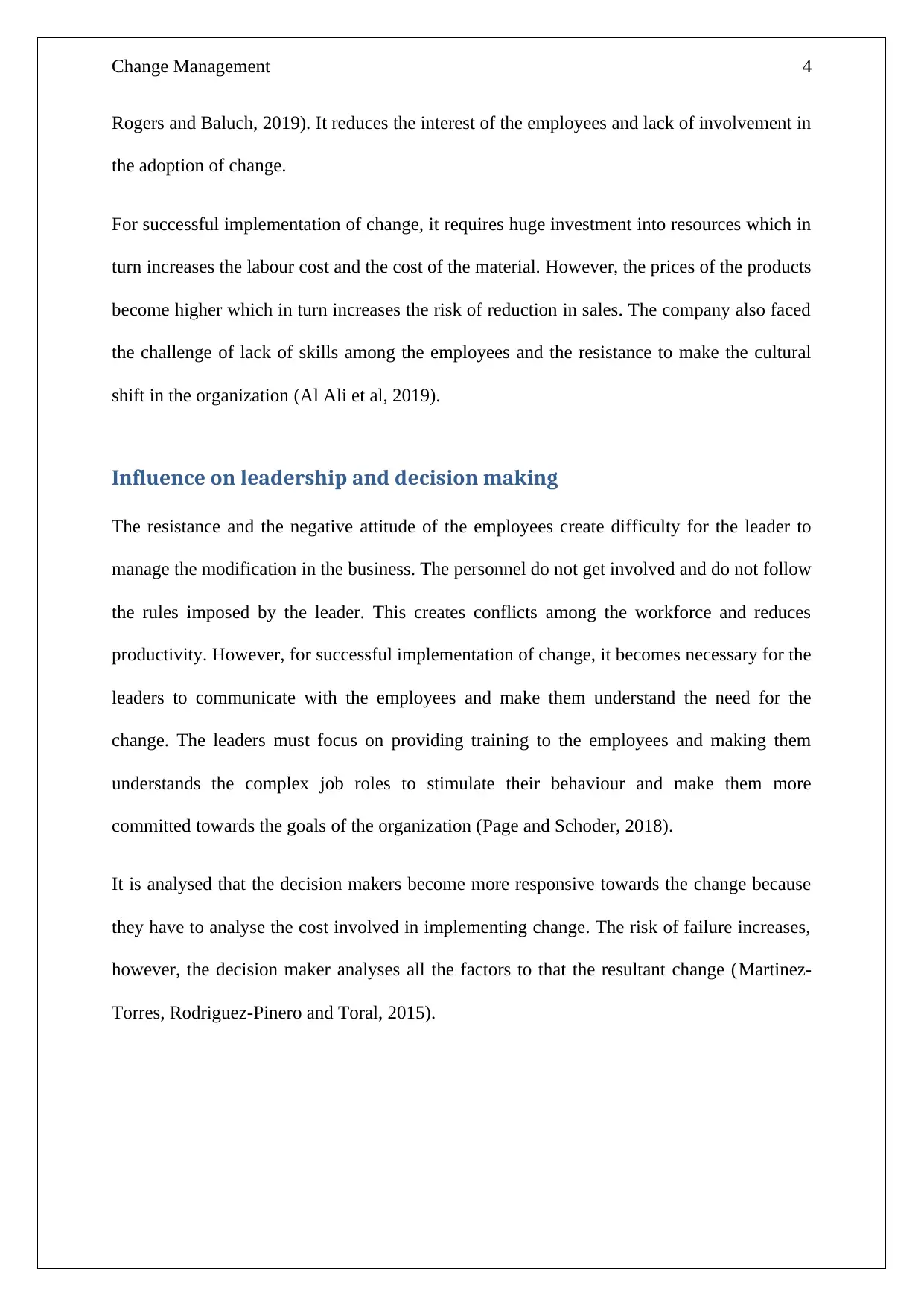
Change Management 4
Rogers and Baluch, 2019). It reduces the interest of the employees and lack of involvement in
the adoption of change.
For successful implementation of change, it requires huge investment into resources which in
turn increases the labour cost and the cost of the material. However, the prices of the products
become higher which in turn increases the risk of reduction in sales. The company also faced
the challenge of lack of skills among the employees and the resistance to make the cultural
shift in the organization (Al Ali et al, 2019).
Influence on leadership and decision making
The resistance and the negative attitude of the employees create difficulty for the leader to
manage the modification in the business. The personnel do not get involved and do not follow
the rules imposed by the leader. This creates conflicts among the workforce and reduces
productivity. However, for successful implementation of change, it becomes necessary for the
leaders to communicate with the employees and make them understand the need for the
change. The leaders must focus on providing training to the employees and making them
understands the complex job roles to stimulate their behaviour and make them more
committed towards the goals of the organization (Page and Schoder, 2018).
It is analysed that the decision makers become more responsive towards the change because
they have to analyse the cost involved in implementing change. The risk of failure increases,
however, the decision maker analyses all the factors to that the resultant change (Martinez-
Torres, Rodriguez-Pinero and Toral, 2015).
Rogers and Baluch, 2019). It reduces the interest of the employees and lack of involvement in
the adoption of change.
For successful implementation of change, it requires huge investment into resources which in
turn increases the labour cost and the cost of the material. However, the prices of the products
become higher which in turn increases the risk of reduction in sales. The company also faced
the challenge of lack of skills among the employees and the resistance to make the cultural
shift in the organization (Al Ali et al, 2019).
Influence on leadership and decision making
The resistance and the negative attitude of the employees create difficulty for the leader to
manage the modification in the business. The personnel do not get involved and do not follow
the rules imposed by the leader. This creates conflicts among the workforce and reduces
productivity. However, for successful implementation of change, it becomes necessary for the
leaders to communicate with the employees and make them understand the need for the
change. The leaders must focus on providing training to the employees and making them
understands the complex job roles to stimulate their behaviour and make them more
committed towards the goals of the organization (Page and Schoder, 2018).
It is analysed that the decision makers become more responsive towards the change because
they have to analyse the cost involved in implementing change. The risk of failure increases,
however, the decision maker analyses all the factors to that the resultant change (Martinez-
Torres, Rodriguez-Pinero and Toral, 2015).
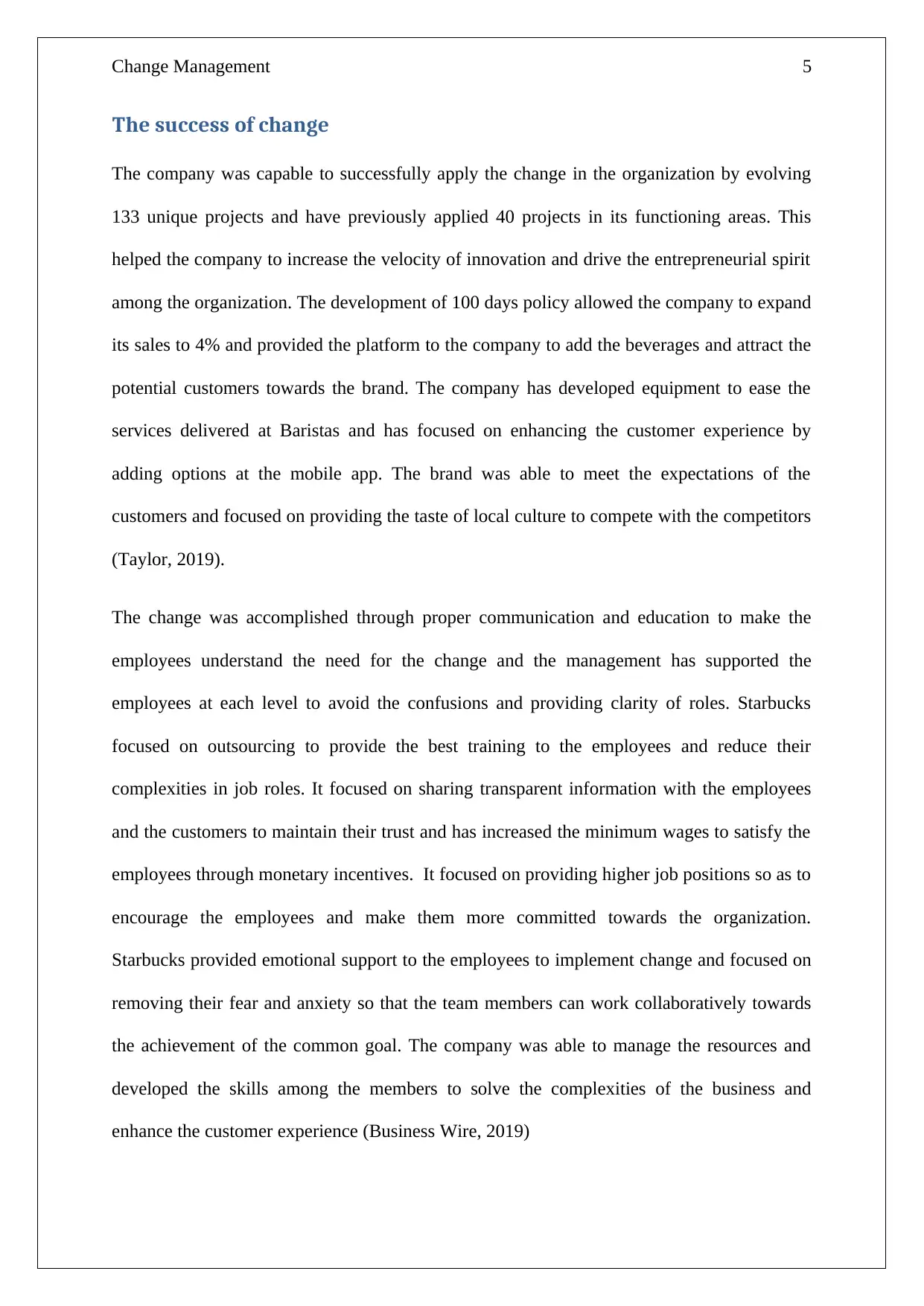
Change Management 5
The success of change
The company was capable to successfully apply the change in the organization by evolving
133 unique projects and have previously applied 40 projects in its functioning areas. This
helped the company to increase the velocity of innovation and drive the entrepreneurial spirit
among the organization. The development of 100 days policy allowed the company to expand
its sales to 4% and provided the platform to the company to add the beverages and attract the
potential customers towards the brand. The company has developed equipment to ease the
services delivered at Baristas and has focused on enhancing the customer experience by
adding options at the mobile app. The brand was able to meet the expectations of the
customers and focused on providing the taste of local culture to compete with the competitors
(Taylor, 2019).
The change was accomplished through proper communication and education to make the
employees understand the need for the change and the management has supported the
employees at each level to avoid the confusions and providing clarity of roles. Starbucks
focused on outsourcing to provide the best training to the employees and reduce their
complexities in job roles. It focused on sharing transparent information with the employees
and the customers to maintain their trust and has increased the minimum wages to satisfy the
employees through monetary incentives. It focused on providing higher job positions so as to
encourage the employees and make them more committed towards the organization.
Starbucks provided emotional support to the employees to implement change and focused on
removing their fear and anxiety so that the team members can work collaboratively towards
the achievement of the common goal. The company was able to manage the resources and
developed the skills among the members to solve the complexities of the business and
enhance the customer experience (Business Wire, 2019).
The success of change
The company was capable to successfully apply the change in the organization by evolving
133 unique projects and have previously applied 40 projects in its functioning areas. This
helped the company to increase the velocity of innovation and drive the entrepreneurial spirit
among the organization. The development of 100 days policy allowed the company to expand
its sales to 4% and provided the platform to the company to add the beverages and attract the
potential customers towards the brand. The company has developed equipment to ease the
services delivered at Baristas and has focused on enhancing the customer experience by
adding options at the mobile app. The brand was able to meet the expectations of the
customers and focused on providing the taste of local culture to compete with the competitors
(Taylor, 2019).
The change was accomplished through proper communication and education to make the
employees understand the need for the change and the management has supported the
employees at each level to avoid the confusions and providing clarity of roles. Starbucks
focused on outsourcing to provide the best training to the employees and reduce their
complexities in job roles. It focused on sharing transparent information with the employees
and the customers to maintain their trust and has increased the minimum wages to satisfy the
employees through monetary incentives. It focused on providing higher job positions so as to
encourage the employees and make them more committed towards the organization.
Starbucks provided emotional support to the employees to implement change and focused on
removing their fear and anxiety so that the team members can work collaboratively towards
the achievement of the common goal. The company was able to manage the resources and
developed the skills among the members to solve the complexities of the business and
enhance the customer experience (Business Wire, 2019).
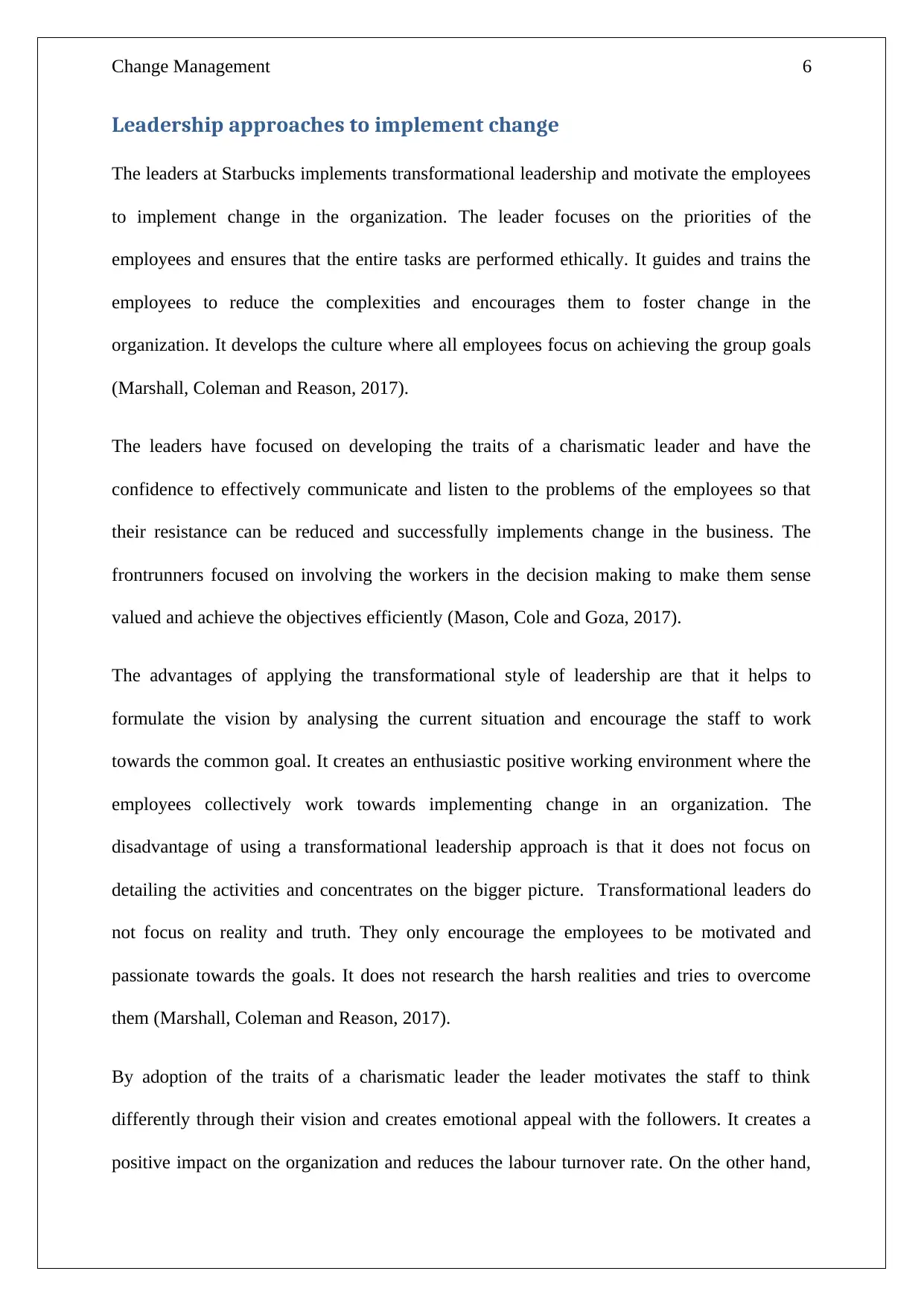
Change Management 6
Leadership approaches to implement change
The leaders at Starbucks implements transformational leadership and motivate the employees
to implement change in the organization. The leader focuses on the priorities of the
employees and ensures that the entire tasks are performed ethically. It guides and trains the
employees to reduce the complexities and encourages them to foster change in the
organization. It develops the culture where all employees focus on achieving the group goals
(Marshall, Coleman and Reason, 2017).
The leaders have focused on developing the traits of a charismatic leader and have the
confidence to effectively communicate and listen to the problems of the employees so that
their resistance can be reduced and successfully implements change in the business. The
frontrunners focused on involving the workers in the decision making to make them sense
valued and achieve the objectives efficiently (Mason, Cole and Goza, 2017).
The advantages of applying the transformational style of leadership are that it helps to
formulate the vision by analysing the current situation and encourage the staff to work
towards the common goal. It creates an enthusiastic positive working environment where the
employees collectively work towards implementing change in an organization. The
disadvantage of using a transformational leadership approach is that it does not focus on
detailing the activities and concentrates on the bigger picture. Transformational leaders do
not focus on reality and truth. They only encourage the employees to be motivated and
passionate towards the goals. It does not research the harsh realities and tries to overcome
them (Marshall, Coleman and Reason, 2017).
By adoption of the traits of a charismatic leader the leader motivates the staff to think
differently through their vision and creates emotional appeal with the followers. It creates a
positive impact on the organization and reduces the labour turnover rate. On the other hand,
Leadership approaches to implement change
The leaders at Starbucks implements transformational leadership and motivate the employees
to implement change in the organization. The leader focuses on the priorities of the
employees and ensures that the entire tasks are performed ethically. It guides and trains the
employees to reduce the complexities and encourages them to foster change in the
organization. It develops the culture where all employees focus on achieving the group goals
(Marshall, Coleman and Reason, 2017).
The leaders have focused on developing the traits of a charismatic leader and have the
confidence to effectively communicate and listen to the problems of the employees so that
their resistance can be reduced and successfully implements change in the business. The
frontrunners focused on involving the workers in the decision making to make them sense
valued and achieve the objectives efficiently (Mason, Cole and Goza, 2017).
The advantages of applying the transformational style of leadership are that it helps to
formulate the vision by analysing the current situation and encourage the staff to work
towards the common goal. It creates an enthusiastic positive working environment where the
employees collectively work towards implementing change in an organization. The
disadvantage of using a transformational leadership approach is that it does not focus on
detailing the activities and concentrates on the bigger picture. Transformational leaders do
not focus on reality and truth. They only encourage the employees to be motivated and
passionate towards the goals. It does not research the harsh realities and tries to overcome
them (Marshall, Coleman and Reason, 2017).
By adoption of the traits of a charismatic leader the leader motivates the staff to think
differently through their vision and creates emotional appeal with the followers. It creates a
positive impact on the organization and reduces the labour turnover rate. On the other hand,
Paraphrase This Document
Need a fresh take? Get an instant paraphrase of this document with our AI Paraphraser
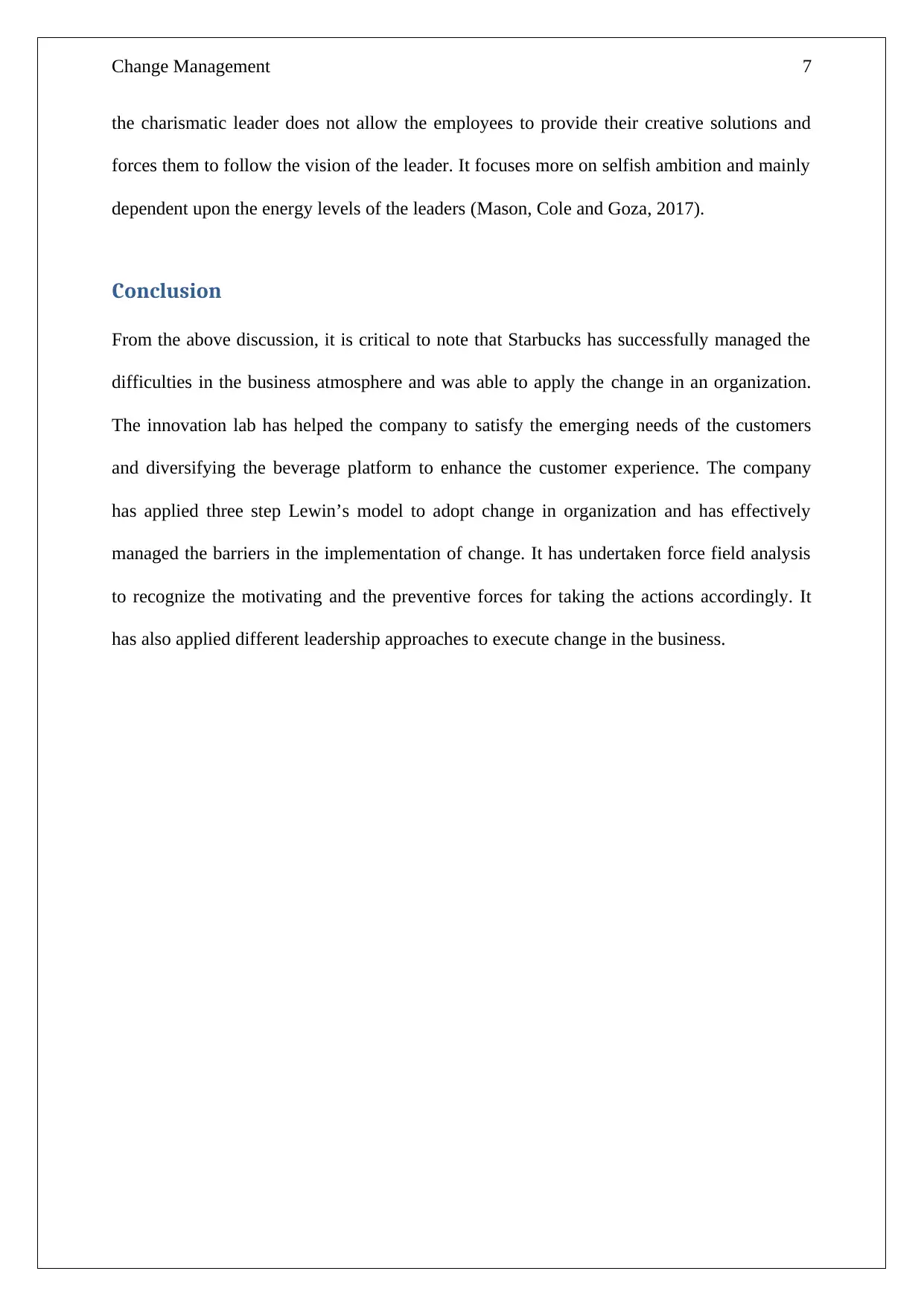
Change Management 7
the charismatic leader does not allow the employees to provide their creative solutions and
forces them to follow the vision of the leader. It focuses more on selfish ambition and mainly
dependent upon the energy levels of the leaders (Mason, Cole and Goza, 2017).
Conclusion
From the above discussion, it is critical to note that Starbucks has successfully managed the
difficulties in the business atmosphere and was able to apply the change in an organization.
The innovation lab has helped the company to satisfy the emerging needs of the customers
and diversifying the beverage platform to enhance the customer experience. The company
has applied three step Lewin’s model to adopt change in organization and has effectively
managed the barriers in the implementation of change. It has undertaken force field analysis
to recognize the motivating and the preventive forces for taking the actions accordingly. It
has also applied different leadership approaches to execute change in the business.
the charismatic leader does not allow the employees to provide their creative solutions and
forces them to follow the vision of the leader. It focuses more on selfish ambition and mainly
dependent upon the energy levels of the leaders (Mason, Cole and Goza, 2017).
Conclusion
From the above discussion, it is critical to note that Starbucks has successfully managed the
difficulties in the business atmosphere and was able to apply the change in an organization.
The innovation lab has helped the company to satisfy the emerging needs of the customers
and diversifying the beverage platform to enhance the customer experience. The company
has applied three step Lewin’s model to adopt change in organization and has effectively
managed the barriers in the implementation of change. It has undertaken force field analysis
to recognize the motivating and the preventive forces for taking the actions accordingly. It
has also applied different leadership approaches to execute change in the business.
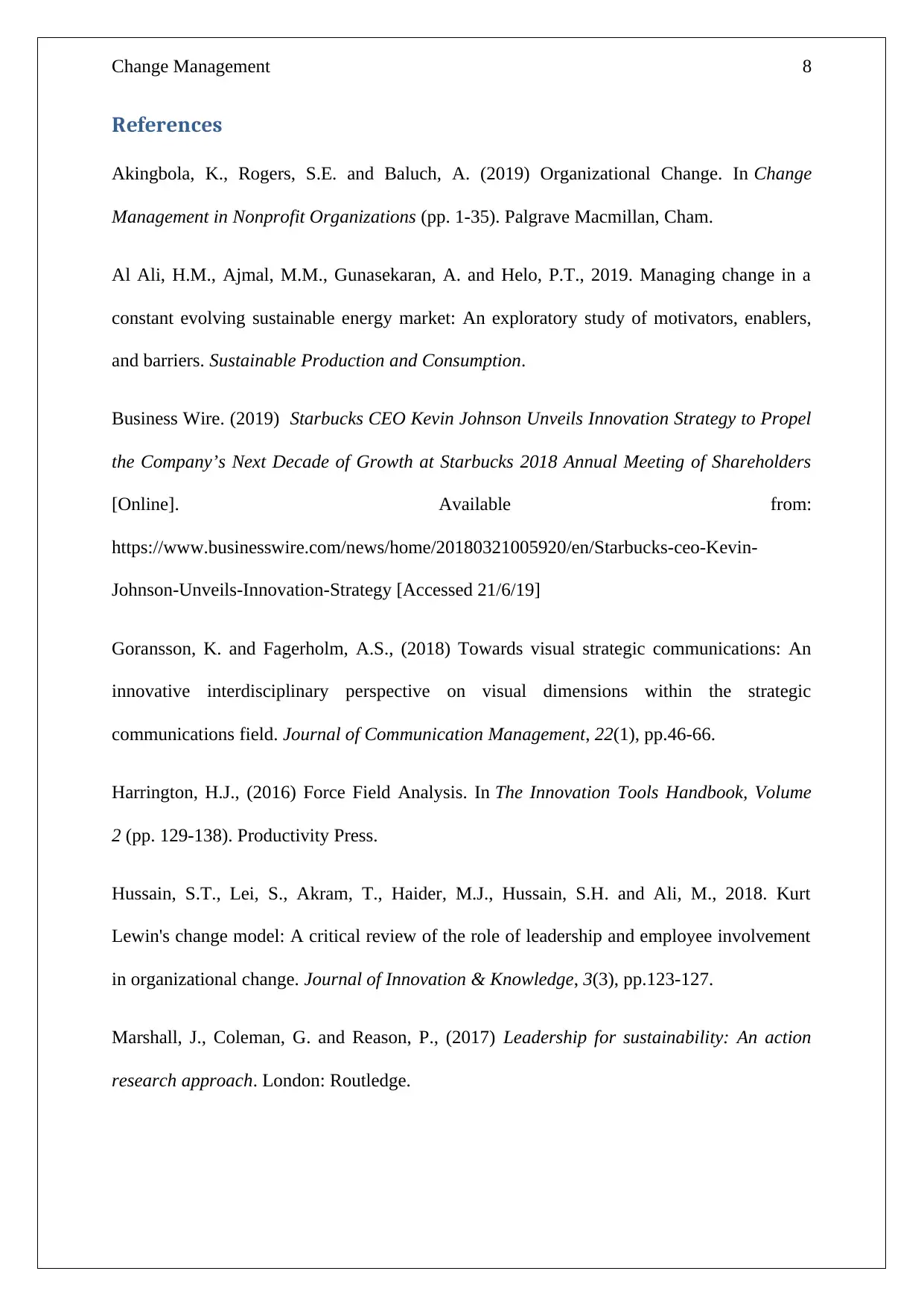
Change Management 8
References
Akingbola, K., Rogers, S.E. and Baluch, A. (2019) Organizational Change. In Change
Management in Nonprofit Organizations (pp. 1-35). Palgrave Macmillan, Cham.
Al Ali, H.M., Ajmal, M.M., Gunasekaran, A. and Helo, P.T., 2019. Managing change in a
constant evolving sustainable energy market: An exploratory study of motivators, enablers,
and barriers. Sustainable Production and Consumption.
Business Wire. (2019) Starbucks CEO Kevin Johnson Unveils Innovation Strategy to Propel
the Company’s Next Decade of Growth at Starbucks 2018 Annual Meeting of Shareholders
[Online]. Available from:
https://www.businesswire.com/news/home/20180321005920/en/Starbucks-ceo-Kevin-
Johnson-Unveils-Innovation-Strategy [Accessed 21/6/19]
Goransson, K. and Fagerholm, A.S., (2018) Towards visual strategic communications: An
innovative interdisciplinary perspective on visual dimensions within the strategic
communications field. Journal of Communication Management, 22(1), pp.46-66.
Harrington, H.J., (2016) Force Field Analysis. In The Innovation Tools Handbook, Volume
2 (pp. 129-138). Productivity Press.
Hussain, S.T., Lei, S., Akram, T., Haider, M.J., Hussain, S.H. and Ali, M., 2018. Kurt
Lewin's change model: A critical review of the role of leadership and employee involvement
in organizational change. Journal of Innovation & Knowledge, 3(3), pp.123-127.
Marshall, J., Coleman, G. and Reason, P., (2017) Leadership for sustainability: An action
research approach. London: Routledge.
References
Akingbola, K., Rogers, S.E. and Baluch, A. (2019) Organizational Change. In Change
Management in Nonprofit Organizations (pp. 1-35). Palgrave Macmillan, Cham.
Al Ali, H.M., Ajmal, M.M., Gunasekaran, A. and Helo, P.T., 2019. Managing change in a
constant evolving sustainable energy market: An exploratory study of motivators, enablers,
and barriers. Sustainable Production and Consumption.
Business Wire. (2019) Starbucks CEO Kevin Johnson Unveils Innovation Strategy to Propel
the Company’s Next Decade of Growth at Starbucks 2018 Annual Meeting of Shareholders
[Online]. Available from:
https://www.businesswire.com/news/home/20180321005920/en/Starbucks-ceo-Kevin-
Johnson-Unveils-Innovation-Strategy [Accessed 21/6/19]
Goransson, K. and Fagerholm, A.S., (2018) Towards visual strategic communications: An
innovative interdisciplinary perspective on visual dimensions within the strategic
communications field. Journal of Communication Management, 22(1), pp.46-66.
Harrington, H.J., (2016) Force Field Analysis. In The Innovation Tools Handbook, Volume
2 (pp. 129-138). Productivity Press.
Hussain, S.T., Lei, S., Akram, T., Haider, M.J., Hussain, S.H. and Ali, M., 2018. Kurt
Lewin's change model: A critical review of the role of leadership and employee involvement
in organizational change. Journal of Innovation & Knowledge, 3(3), pp.123-127.
Marshall, J., Coleman, G. and Reason, P., (2017) Leadership for sustainability: An action
research approach. London: Routledge.
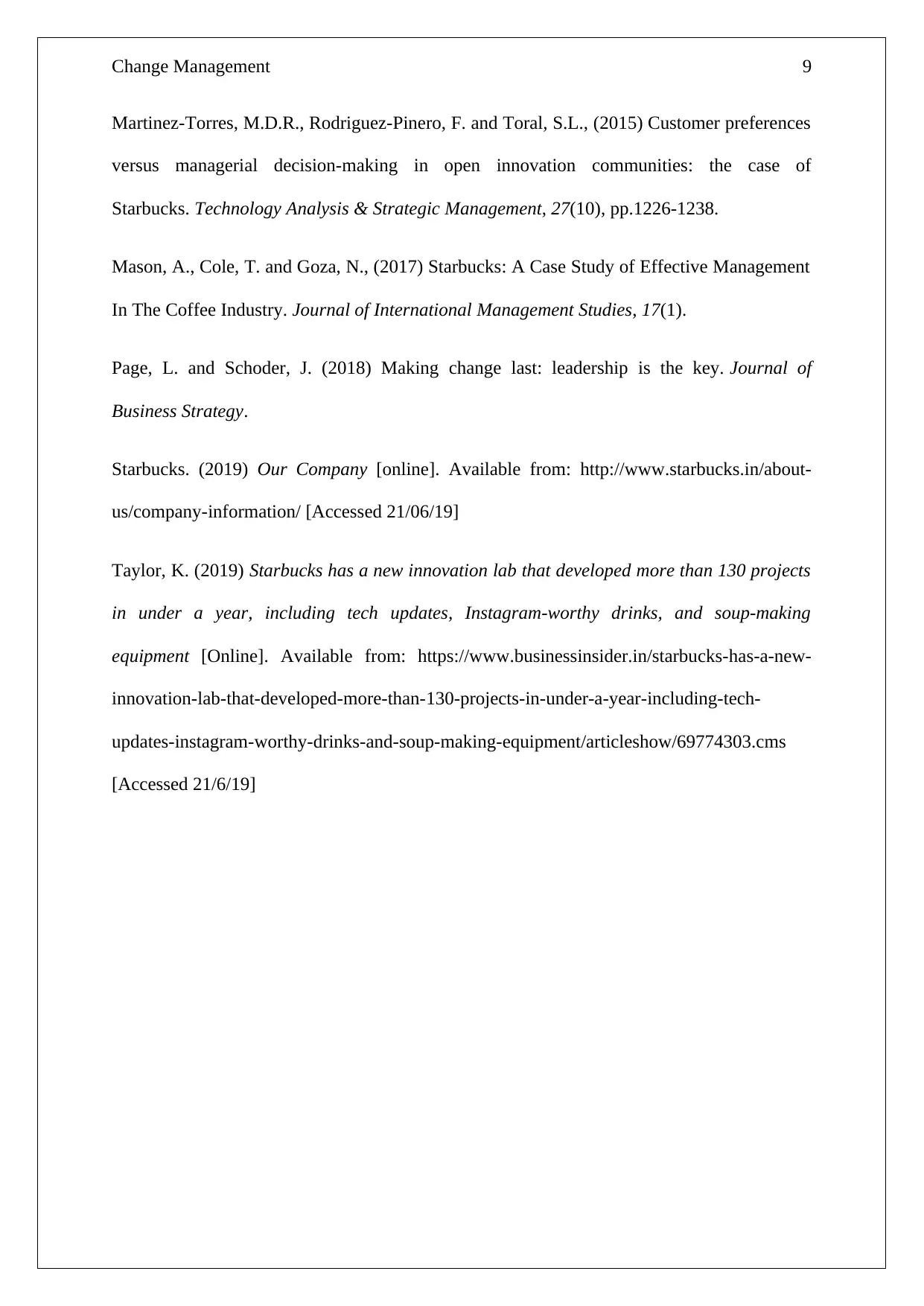
Change Management 9
Martinez-Torres, M.D.R., Rodriguez-Pinero, F. and Toral, S.L., (2015) Customer preferences
versus managerial decision-making in open innovation communities: the case of
Starbucks. Technology Analysis & Strategic Management, 27(10), pp.1226-1238.
Mason, A., Cole, T. and Goza, N., (2017) Starbucks: A Case Study of Effective Management
In The Coffee Industry. Journal of International Management Studies, 17(1).
Page, L. and Schoder, J. (2018) Making change last: leadership is the key. Journal of
Business Strategy.
Starbucks. (2019) Our Company [online]. Available from: http://www.starbucks.in/about-
us/company-information/ [Accessed 21/06/19]
Taylor, K. (2019) Starbucks has a new innovation lab that developed more than 130 projects
in under a year, including tech updates, Instagram-worthy drinks, and soup-making
equipment [Online]. Available from: https://www.businessinsider.in/starbucks-has-a-new-
innovation-lab-that-developed-more-than-130-projects-in-under-a-year-including-tech-
updates-instagram-worthy-drinks-and-soup-making-equipment/articleshow/69774303.cms
[Accessed 21/6/19]
Martinez-Torres, M.D.R., Rodriguez-Pinero, F. and Toral, S.L., (2015) Customer preferences
versus managerial decision-making in open innovation communities: the case of
Starbucks. Technology Analysis & Strategic Management, 27(10), pp.1226-1238.
Mason, A., Cole, T. and Goza, N., (2017) Starbucks: A Case Study of Effective Management
In The Coffee Industry. Journal of International Management Studies, 17(1).
Page, L. and Schoder, J. (2018) Making change last: leadership is the key. Journal of
Business Strategy.
Starbucks. (2019) Our Company [online]. Available from: http://www.starbucks.in/about-
us/company-information/ [Accessed 21/06/19]
Taylor, K. (2019) Starbucks has a new innovation lab that developed more than 130 projects
in under a year, including tech updates, Instagram-worthy drinks, and soup-making
equipment [Online]. Available from: https://www.businessinsider.in/starbucks-has-a-new-
innovation-lab-that-developed-more-than-130-projects-in-under-a-year-including-tech-
updates-instagram-worthy-drinks-and-soup-making-equipment/articleshow/69774303.cms
[Accessed 21/6/19]
Secure Best Marks with AI Grader
Need help grading? Try our AI Grader for instant feedback on your assignments.
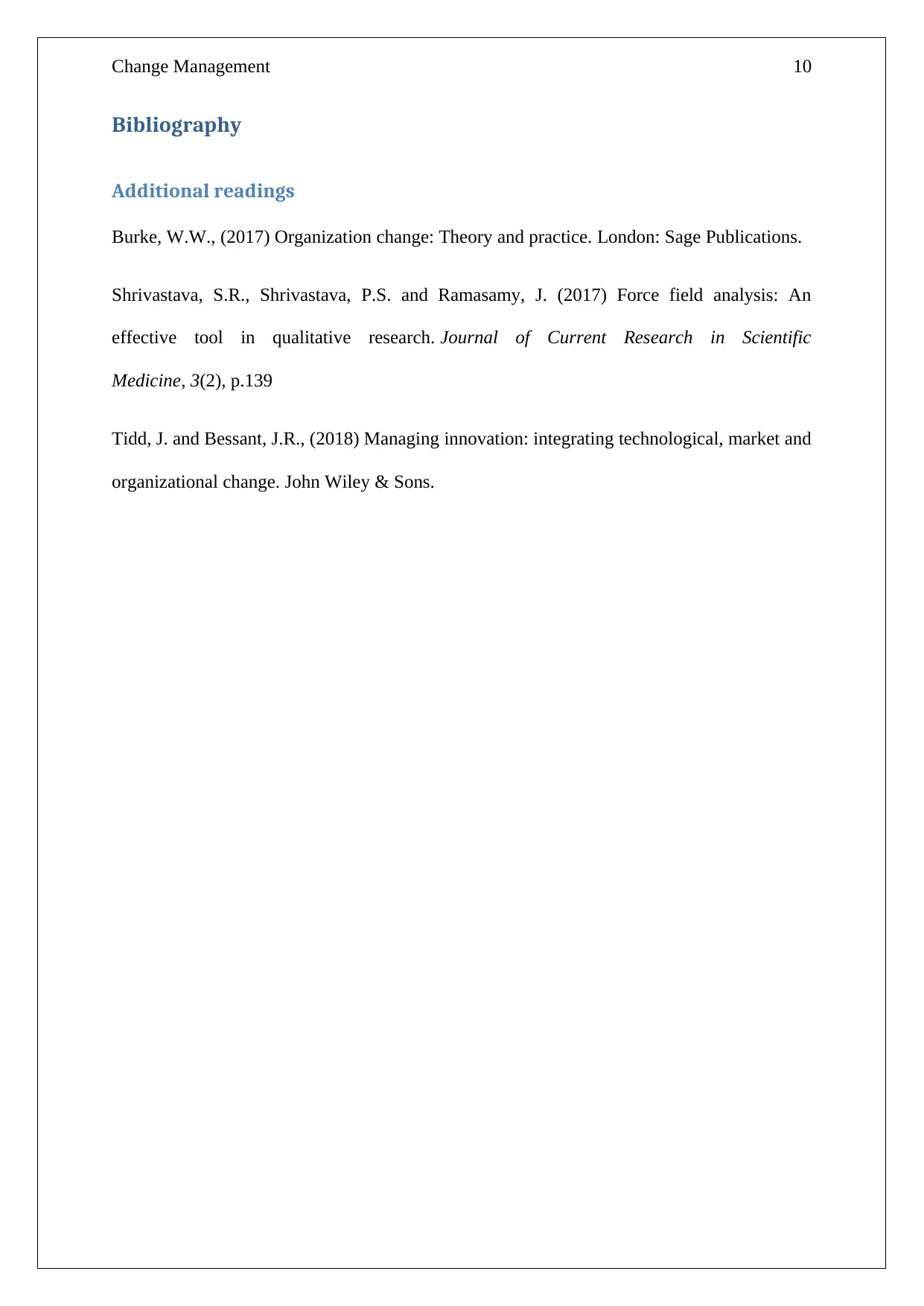
Change Management 10
Bibliography
Additional readings
Burke, W.W., (2017) Organization change: Theory and practice. London: Sage Publications.
Shrivastava, S.R., Shrivastava, P.S. and Ramasamy, J. (2017) Force field analysis: An
effective tool in qualitative research. Journal of Current Research in Scientific
Medicine, 3(2), p.139
Tidd, J. and Bessant, J.R., (2018) Managing innovation: integrating technological, market and
organizational change. John Wiley & Sons.
Bibliography
Additional readings
Burke, W.W., (2017) Organization change: Theory and practice. London: Sage Publications.
Shrivastava, S.R., Shrivastava, P.S. and Ramasamy, J. (2017) Force field analysis: An
effective tool in qualitative research. Journal of Current Research in Scientific
Medicine, 3(2), p.139
Tidd, J. and Bessant, J.R., (2018) Managing innovation: integrating technological, market and
organizational change. John Wiley & Sons.
1 out of 11
Related Documents
Your All-in-One AI-Powered Toolkit for Academic Success.
+13062052269
info@desklib.com
Available 24*7 on WhatsApp / Email
![[object Object]](/_next/static/media/star-bottom.7253800d.svg)
Unlock your academic potential
© 2024 | Zucol Services PVT LTD | All rights reserved.




